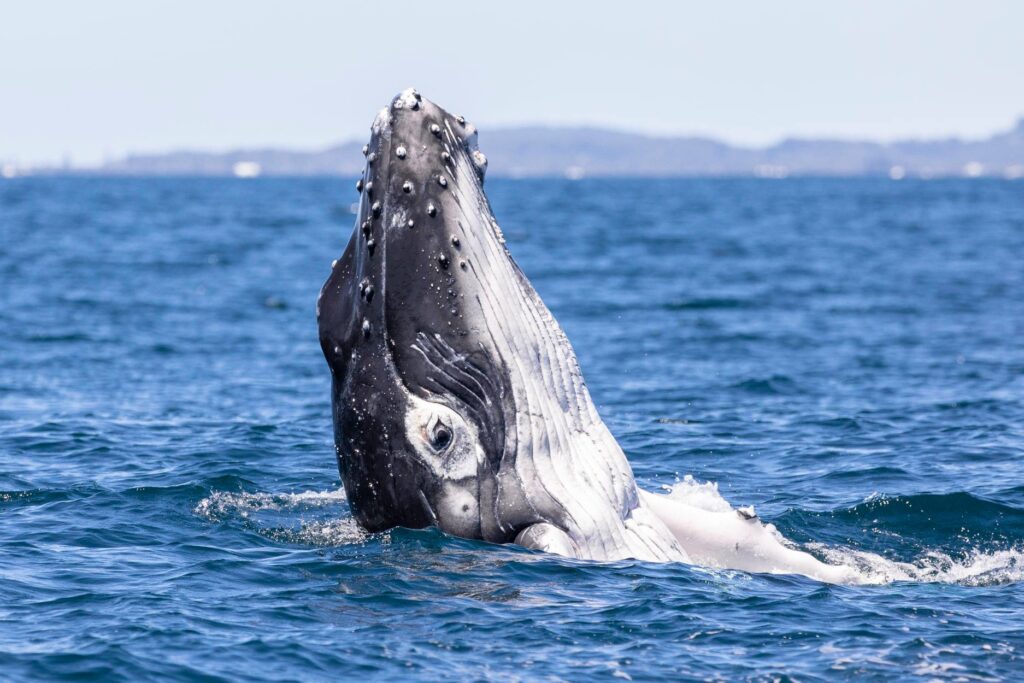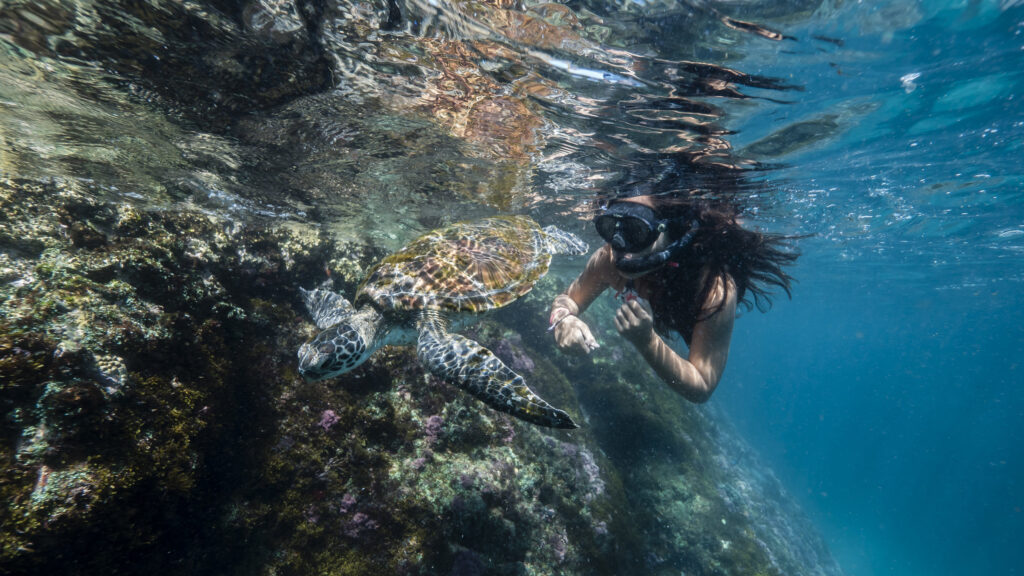What really makes Julian Rocks ‘Nguthungulli’ Nature Reserve special is its abundant marine diversity.
Come discover this unique underwater ecosystem and let our marine naturalist introduce you to some of the most incredible marine species during your Byron Bay snorkelling tour!
Sea Turtles
Julian Rocks is home to large numbers of sea turtles. The 3 species you will most likely encounter are the green, loggerhead and hawksbill turtles. The great thing with swimming with our resident turtles is that they aren’t shy and you could very likely come face-to-face with them as they come to the surface to breathe!
All marine turtle species are experiencing serious threats to their survival including pollution, fisheries bycatch, changes to habitats and climate change.
In Australia, the green and hawksbill turtle are each listed as vulnerable while the loggerhead turtle is listed as endangered.
Best time : all year round
Did you know? Turtles have lived in the oceans for over 100 million years, since the time of dinosaurs.
Leopard Sharks (Stegastoma fasciatum)
Julian Rocks is one of the world’s largest aggregations of leopard shark and you can find yourself swimming with dozens and dozens of leopard sharks around you.
Harmless and docile, the leopard sharks have beautiful spotted patterns and gracefully glide through the water smoothly swinging their long tails.
Adults typically reach an average length of about 2.4 meters.
Nocturnal bottom-feeders, their diet consist mainly on molluscs, crustaceans and small bony fishes.
They are currently classified as ‘Endangered’ on the IUCN Red List of Threatened Species, mainly due to overfishing.
Best time : December till May
Did you know? In other parts of the world, they are know as Zebra sharks due to their juvenile appearance with black and white stripes. This is confusing as there is another species called the Leopard shark (Triakis semifasciata) found along the Pacific North American coast!
Manta Ray (Mobula alfredi)
During summer, Manta rays are common visitors to Julian Rocks.
Mantas are amongst the largest fish in the ocean with a wing span of up to 7 metres. Despite their size, manta rays are harmless giants and they do not have a stinging barb.
They are filter feeders, eating the microscopic zooplankton that drift along in the ocean currents.
Manta rays have the largest brain to body size ratio of any living fish and are very aware and interactive with divers.
Snorkeling with a manta ray is an unforgettable experience.
Targeted by fisheries in various parts of the world it has resulted in being listed as Vulnerable to Extinction in the IUCN Red List of Threatened Species.
Best time : December till May
Did you know? “Manta” translates to blanket or cloak in Spanish, which very well describes the look of the animals’ large, flat, diamond-shaped bodies.
Fish
With over 500 tropical and temperate fish species, you’ll be fascinated by their incredible variety of colours, shape and size.
From the small and shiny Blue Tang to large schools of Trevally, Sweetlips and Bullseyes, their diversity create an outstanding underwater ecosystem.
Several protected fish species are also found at Julian Rocks including the estuary cod and giant Queensland groper.
Best time : all year round
Did you know? Eastern Blue Groper are hermaphrodites and may change sex from female to male during their life cycle.
Grey Nurse Sharks (Carcharias taurus)
Despite their ferocious look with pointy teeth sticking out of their mouths, the Grey Nurse Shark are placid and inoffensive and it’s totally safe to dive with them.
They can grow up to 3.2 metre and feed on fish, squid and crustaceans at night.
In the 1950s and 1960s, the misconception that Grey Nurse Sharks were ‘man-eaters’ led to intensive fishing efforts by spearfishers.
A New South Wales Fisheries survey in 2000 estimated the total population to be less than 300.
The Grey Nurse Shark is currently classified as “Critically Endangered” along the East Coast of Australia and Julian Rocks has been identified as a critical habitat for grey nurse sharks, a vital environment to their survival.
Best time : May till December
Did you know? Male Grey Nurse Sharks bite females during the courtship process. In the breeding season it is common to see small scars on the females.
White-spotted Eagle Rays (Aetobatus ocellatus)
White-spotted Eagle Rays can be seen gracefully swimming alone or in large fevers, which are fantastic to witness.
These active swimmers can reach a width of 3 metres and possess an incredibly long whip-like tail.
As their name suggest, they have a number of white spots on their back, forming patterns unique to each individual.
Threats to Eagle rays include bycatch, artisanal gillnet fisheries and collection for the marine aquarium trade.
Best time : All year round
Did you know? Eagle ray can sometimes jump out of the water! A few theories of why they do this are to remove parasites, avoid predators or chasing food.
Wobbegongs (Orectolobus spp.)
Julian Rocks could also be called Wobbegong City with hundreds of them present all year around.
3 species have been identified : Spotted Wobbegongs (Orectolobus maculatus), Ornate Wobbegong (Orectolobus ornatus) and Banded Wobbegong (Orectolobus halei).
They can often be missed due to their excellent camouflage and motionless resting at the bottom during the day, also it is not uncommon to see them piling on top of each other.
Best time : All year round
Did you know? The name Wobbegong comes from the aboriginal word meaning “shaggy beard”, referring to the growths around their mouth.
octopus (Octopus spp.)
Octopuses are considered to be the most intelligent of all invertebrates and have 9 brains. 1 central brain and 8 mini-brains, so each tentacles can act independently.
These master of camouflage can be tricky to find as they can change the colour of there skin.
Most octopus species live for 12-18 months and breed only once during their life.
Best time : All year round
Did you know? Octopuses have 3 hearts and blue blood!
Nudibranches
These tiny “butterflies of the sea” have the most fascinating shapes and magnificent colours!
They can be hard to spot at first due to their small size but try looking on the rocks but beneath the surface of the water and you’ll be amazed!
They are soft-bodied molluscs and hermaphrodites, which allows them to mate with any other mature member of their species
About 3,000 species of nudibranchs are known worldwide and new species are still being discovered each year.
Best time : All year round
Did you know?
Their colour is derived from what they eat which helps in camouflage and some even steal the defences of the animals they feed on, from the stinging cells of jellyfish to the toxins of sponges.


